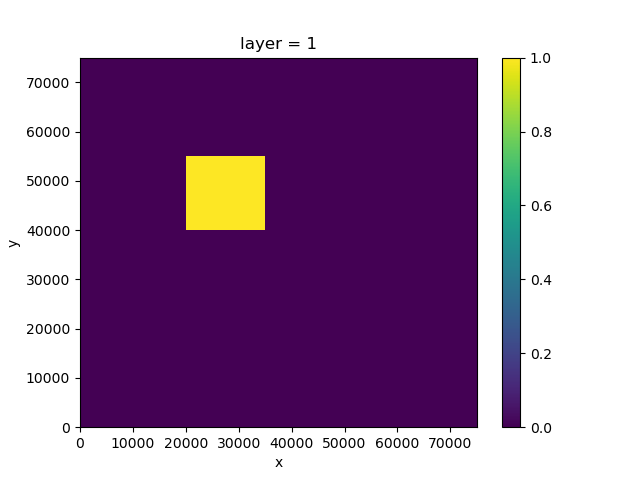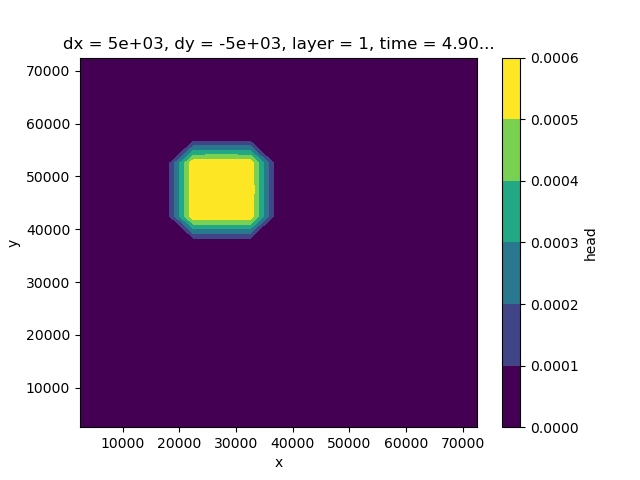Note
Go to the end to download the full example code.
Lake package example#
This is a synthetic example (using invented, not necesarily physical data) of how to use the lake package api to generate models with lakes.
In overview, we’ll set the following steps:
Create a structured grid for a rectangular geometry.
Create a constant head boundary
Create packages for initial conditions, output control, storage, and node property flow
Create a lake package with a time-dependent rainfall
Write to modflow6 files.
Run the model.
Open the results back into DataArrays.
Visualize the results.
We’ll start with the usual imports. As this is an simple (synthetic) structured model, we can make due with few packages.
import numpy as np
import xarray as xr
import imod
import imod.mf6.lak as lak
nlay = 3
nrow = 15
ncol = 15
shape = (nlay, nrow, ncol)
dx = 5000.0
dy = -5000.0
xmin = 0.0
xmax = dx * ncol
ymin = 0.0
ymax = abs(dy) * nrow
dims = ("layer", "y", "x")
layer = np.array([1, 2, 3])
y = np.arange(ymax, ymin, dy) + 0.5 * dy
x = np.arange(xmin, xmax, dx) + 0.5 * dx
coords = {"layer": layer, "y": y, "x": x}
idomain = xr.DataArray(np.ones(shape, dtype=int), coords=coords, dims=dims)
lake_layer = 1
lake_x = x[4:7]
lake_y = y[4:7]
is_lake = xr.full_like(idomain, fill_value=False, dtype=bool)
is_lake.loc[{"layer": lake_layer, "x": lake_x, "y": lake_y}] = True
is_lake.sel(layer=1).plot.imshow()

<matplotlib.image.AxesImage object at 0x0000019B359E1130>
VERTICAL = 1
connectionType = xr.where(is_lake, VERTICAL, np.nan)
bed_leak = xr.where(is_lake, 0.2, np.nan)
top_elevation = xr.where(is_lake, 0.4, np.nan)
bot_elevation = xr.where(is_lake, 0.1, np.nan)
connection_length = xr.where(is_lake, 0.5, np.nan)
connection_width = xr.where(is_lake, 0.6, np.nan)
times_rainfall = [
np.datetime64("2000-01-01"),
np.datetime64("2000-03-01"),
np.datetime64("2000-05-01"),
]
rainfall = xr.DataArray(
np.full((len(times_rainfall)), 0.001),
coords={"time": times_rainfall},
dims=["time"],
)
lake = lak.LakeData(
10.0,
"Nieuwkoopse_plas",
connectionType,
bed_leak,
top_elevation,
bot_elevation,
connection_length,
connection_width,
None,
None,
rainfall,
None,
None,
None,
None,
None,
)
Create grid coordinates#
The first steps consist of setting up the grid – first the number of layer, rows, and columns. Cell sizes are constant throughout the model.
We’ll create a new directory in which we will write and run the model.
modeldir = imod.util.temporary_directory()
Create DataArrays#
Now that we have the grid coordinates setup, we can start defining model parameters. The model is characterized by:
a constant head boundary on the left
a single drain in the center left of the model
uniform recharge on the top layer
bottom = xr.DataArray([-200.0, -300.0, -450.0], {"layer": layer}, ("layer",))
# Constant head
constant_head = xr.full_like(idomain, np.nan, dtype=float).sel(layer=[1, 2])
constant_head[..., 0] = 0.0
# Node properties
icelltype = xr.DataArray([1, 0, 0], {"layer": layer}, ("layer",))
k = xr.DataArray([1.0e-3, 1.0e-4, 2.0e-4], {"layer": layer}, ("layer",))
k33 = xr.DataArray([2.0e-8, 2.0e-8, 2.0e-8], {"layer": layer}, ("layer",))
gwf_model = imod.mf6.GroundwaterFlowModel()
gwf_model["dis"] = imod.mf6.StructuredDiscretization(
top=200.0, bottom=bottom, idomain=idomain
)
gwf_model["chd"] = imod.mf6.ConstantHead(
constant_head, print_input=True, print_flows=True, save_flows=True
)
gwf_model["ic"] = imod.mf6.InitialConditions(start=0.0)
gwf_model["npf"] = imod.mf6.NodePropertyFlow(
icelltype=icelltype,
k=k,
k33=k33,
variable_vertical_conductance=True,
dewatered=True,
perched=True,
save_flows=True,
)
gwf_model["sto"] = imod.mf6.SpecificStorage(
specific_storage=1.0e-5,
specific_yield=0.15,
transient=True,
convertible=0,
)
gwf_model["oc"] = imod.mf6.OutputControl(save_head="all", save_budget="all")
# Attach it to a simulation
simulation = imod.mf6.Modflow6Simulation("ex01-twri")
simulation["GWF_1"] = gwf_model
# Define solver settings
simulation["solver"] = imod.mf6.Solution(
modelnames=["GWF_1"],
print_option="summary",
outer_dvclose=1.0e-4,
outer_maximum=500,
under_relaxation=None,
inner_dvclose=1.0e-4,
inner_rclose=0.001,
inner_maximum=100,
linear_acceleration="cg",
scaling_method=None,
reordering_method=None,
relaxation_factor=0.97,
)
gwf_model["lake"] = lak.Lake.from_lakes_and_outlets(
[lake],
print_input=True,
print_stage=True,
print_flows=True,
save_flows=True,
stagefile=modeldir / "GWF_1/stagefile.lak",
budgetcsvfile=modeldir / "GWF_1/budgetcsvfile.lak",
package_convergence_filename=modeldir / "GWF_1/convergence.lak",
)
# Collect time discretization
simulation.create_time_discretization(
additional_times=["2000-01-01", "2000-01-02", "2000-01-03", "2013-06-04"]
)
simulation.write(modeldir)
Run the model#
Note
The following lines assume the mf6 executable is available on your PATH.
The MODFLOW 6 examples introduction shortly
describes how to add it to yours.
simulation.run()
Open the results#
We’ll open the heads (.hds) file.
head = imod.mf6.open_hds(
modeldir / "GWF_1/GWF_1.hds",
modeldir / "GWF_1/dis.dis.grb",
)
Visualize the results#
head.isel(layer=0, time=4).plot.contourf()

<matplotlib.contour.QuadContourSet object at 0x0000019B2F1ADF40>
Total running time of the script: (0 minutes 0.677 seconds)